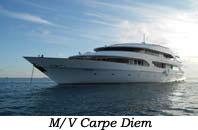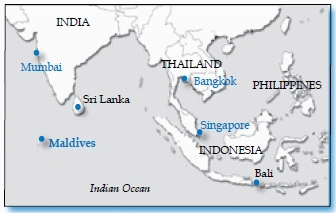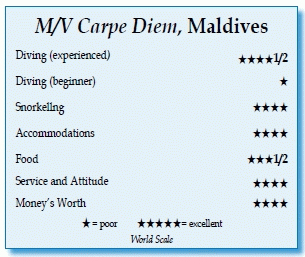M/V Carpe Diem, MaldivesContents of this Issue: This Time, It’s Not the Lionfish’s Fault Why You Might Remove Your Regulator When You Shouldn’t Protected Marine Reserves Are Not So Safe Palau’s Chamber is Working Again, But Not Full-Time DEMA Versus the National Ocean Policy South Korea Bulks Up on Dive Weapons Editorial Office: Ben Davison Publisher and Editor Undercurrent 3020 Bridgeway, Suite 102 Sausalito, CA 94965 the abundance of fish is worth the cost and travel time from the June, 2012 issue of Undercurrent
Dear Fellow Diver: The dinghy captain dropped me in the water in snorkel gear. For a moment, I didn't see a thing. Then emerging from the water, slightly murky from the ample plankton, I saw the whale shark swimming directly otward me, just 10 feet below. Snorkeling faster and faster, I watched in amazement for at least five minutes as the largest fish species in the world swam languidly beneath me, the sun sparkling on its polka-dotted back. Slowly, it pulled ahead of me and disappeared into deeper water. Finally, after thousands of dives, I was no longer a whale shark virgin! This trip yielded two wonderful whale shark encounters, and I'm still smiling.
M/V Carpe Diem, a liveaboard in the Blue O'Two fleet, plies a variety of routes in the Maldives. My itinerary cruised the atolls of North and South Male, North and South Ari, and Vaavu, and it featured a number of channel dives, with often powerful currents, low visibility and big animals. There were 19 divers on board, almost all from the U.K. This trip was all about diving and not so much about luxury. The boat was comfortable, and my suite was roomy and bright with big windows, though the beds were rock-hard. The regular staterooms were smaller but looked comfortable, and no one complained about lack of storage. Meals included plenty of veggies and protein but meats were tough, and sauces lacked spice. Tuna and sailfish caught from the stern of the boat while we were in passage provided the best repasts. A mug of delicious Lion, draught beer from Sri Lanka, was $3. Wines ranged from $24 to $35 a bottle, but they were also available by the glass, as were liquors. I awoke every morning at 6:15, though one morning I climbed out of bed before dawn at 5:15 in order to go look for hammerheads. I had a banana with Nescafe (if you really like coffee, bring your own) and was in the water by 7 a.m. We dived from an updated version of the traditional Maldivian dhoni, a tender that sported a powerful engine and massive membrane nitrox system that the engineer clearly considered his baby. Most dives, usually three per day (excepting the one night dive), went down to 100 feet and lasted about an hour, so nitrox was a necessity. Those few divers on air were severely restricted by their computers. They offered aluminum 80s and magnificent steel 100s. Since I wear a heavy wetsuit, I took advantage of the added weight of steel, though it meant returning with a lot of air after every dive.
Most dives were channel dives, and the current ranged from moderate to impressively strong, like high-speed trains. The weather in January was dry and gorgeous, the water was filled with plankton and life (I have the jellyfish and siphonophore stings on my face to prove it), and visibility was usually low, but that meant big animals. At Rakeedhu, near South Ari, I saw a whale shark, a squadron of eagle rays, a manta, a leopard shark, two hawksbill turtles, tunas and gray reef, white-tip and black-tip sharks in numbers I had not seen outside of Cocos Island. Of course, not every dive was like this, but there were enough high-voltage encounters for me to become blasé when only half a dozen sharks appeared. I delighted in the dives around South Ari Atoll. The teeming fish at sites like the Aquarium gave me hope that the oceans are not overfished yet. I hung on top of a pinnacle and watched clouds of silversides, sliced through by trevally, jacks and snappers. The wreck at Matchafushi Island was not so much interesting as a wreck but as a site of life, with clouds of fish like batfish, unicornfish and other piscavores hunting schools of silversides. A massive green frogfish, which I hope hasn't died of fright, was tormented by photographer after photographer. (I have a rant for another day about how digital photography has spawned environmentally insensitive divers, as cheap digital cameras allows anyone, no matter how lousy their buoyancy, to do it.) Because the Maldives are so isolated, there are a few endemic species such as anemonefishes, or as Marty Snyderman says, the fish invented by Kodak. The black-bellied Maldivian anemonefish, with its handsome white vertical head-tobelly bar, live in the tentacles of glorious heteractus anemones, which invert as the day gets later to expose vivid undersides of pink, purple, and green. The Sebae, the Maldives' other anemonefish, is quite dark with white patches near the face and caudal fin, and has a pugnacious personality that made me glad that they are tiny. My dive buddy discovered that some eels have acquired a taste for human flesh. From time to time, we had to gecko dive, hanging on to dead corals and holes in the reef in order to pull ourselves along in the ripping currents. My buddy stuck a few fingers in a hole already occupied by a blackface eel, which proceeded to chomp down on the offending digit and hunt the poor diver for the rest of his dive. Its teeth did break right through the gloves, but the eel only grazed some knuckles. Because eels don't floss, we made sure the wound stayed clean. Between dives, I did a prodigious amount of napping on my unyielding mattress, suggesting I was truly tired, but sometimes I watched trashy DVDs on my suite's screen. In fact, the impressive amount of between-dives napping all over the boat suggested that though most divers were fit, the currents really take it out of you.
The one night dive was both a highlight and a little terrifying. The boat ran a line 30 feet down to Mayaa Thila in the North Ari atoll, a pinnacle that comes alive at night with hundreds of hunting white-tip sharks, marble rays and big snappers. It also comes alive with ripping current. During my dive, at least five other liveaboards dumped their divers there, so I became disoriented by the lights and, despite my best efforts, could not find the line back to Carpe Diem. After half an hour of my fruitless searching, dive guide Ibu found me and my buddy among the seemingly zillions of divers there, and escorted us back to the correct line. Divers back on board were quite anxious and concerned about our late return, and it resulted in my buying a lot of Lion to repay those divers whose dinners I had held up while they fretted. We enjoyed one evening ashore on a little island where the crew prepared a yummy barbecue. A walking tour of one small village in the South Ari atoll was interesting, but designed to get us into the souvenir shops. I found no impressive crafts, and prices were sky-high due to the isolation of the islands -- and the optimism of the vendors. When the boat pulled into Male on the last afternoon to load up on supplies, I took a walking tour of the city to see its old mosque, with its minaret shaped like a lighthouse, and the produce and fish markets. Other than tourism, fishing is the Maldives' main source of income. With rising sea levels, and the Maldivians' protests about the lack of worldwide action on global warming, it's not hard to imagine that this nation will be covered by seawater at the end of the 21st century. After the liveaboard part of my trip concluded, I booked two nights at the Bandos Island Resort before taking my return flight back via Qatar. I did two more dives but had become so spoiled by the diving in the outer islands that they seemed dull, although a green turtle the size of a VW Beetle finned past me. But it was nice to sleep in a better bed and get a massage. The food was okay, but resorts in the Maldives are impressively expensive, and I chose Bandos in part for its relatively reasonable price. The clientele was lots of Japanese, tons of Russians, folks from various parts of the former Soviet Union, plenty of Brits, and lots of families taking advantage of the kids club. My Jacuzzi villa was a hoot, shaped like a tiki-inspired beehive with a fabulous outdoor bathroom. Next time, I'll decompress at one of the remote resorts in the south atolls. -- A.E.L.
|

I want to get all the stories! Tell me how I can become an Undercurrent Online Member and get online access to all the articles of Undercurrent as well as thousands of first hand reports on dive operations world-wide
| Home | Online Members Area | My Account |
Login
|
Join
|
| Travel Index |
Dive Resort & Liveaboard Reviews
|
Featured Reports
|
Recent
Issues
|
Back Issues
|
|
Dive Gear
Index
|
Health/Safety Index
|
Environment & Misc.
Index
|
Seasonal Planner
|
Blogs
|
Free Articles
|
Book Picks
|
News
|
|
Special Offers
|
RSS
|
FAQ
|
About Us
|
Contact Us
|
Links
|
3020 Bridgeway, Ste 102, Sausalito, Ca 94965
All rights reserved.

 There are two main reasons why the Maldives are
on every diver's bucket list: the diving and the postcard
perfection of the archipelago. Though not lush, the
islands look like ads for "tropical islands," with snowy
sand, swaying palms and crystalline waters. That the diving
rocks is icing on a very beautiful cake. This curious
nation, only a few feet above sea level, consists of more
than 1,000 islands, of which only 200 are occupied by its
319,000 inhabitants. It isn't the center of nowhere, but
you can see it from there -- 430 miles southwest of Sri
Lanka and 250 miles southwest of the tip of India. It's
possibly the world's
most Muslim country;
locals brag
that 100 percent of
the population practice
Islam. Their
customs suggest how
strong beliefs run
-- not only can one
not bring in liquor
or porn, but dogs
are also disallowed.
So no pocket poodles
or Chihuahuas to put under your airline seat. They're
unclean, you see.
There are two main reasons why the Maldives are
on every diver's bucket list: the diving and the postcard
perfection of the archipelago. Though not lush, the
islands look like ads for "tropical islands," with snowy
sand, swaying palms and crystalline waters. That the diving
rocks is icing on a very beautiful cake. This curious
nation, only a few feet above sea level, consists of more
than 1,000 islands, of which only 200 are occupied by its
319,000 inhabitants. It isn't the center of nowhere, but
you can see it from there -- 430 miles southwest of Sri
Lanka and 250 miles southwest of the tip of India. It's
possibly the world's
most Muslim country;
locals brag
that 100 percent of
the population practice
Islam. Their
customs suggest how
strong beliefs run
-- not only can one
not bring in liquor
or porn, but dogs
are also disallowed.
So no pocket poodles
or Chihuahuas to put under your airline seat. They're
unclean, you see. The tender was crowded with 19 divers, who were usually divided into four
groups. Due to powerful currents, we were asked to stay with the guides, except
for certain dives when buddy diving was okay. All divers were required to carry
a surface signaling device on a reel. The boat will provide one, but currents
are hairy enough that it makes sense to have your own device that you know and
can use easily so you don't end up drifting off to India. The Maldivian guides
spoke English decently, and at least one had a university education in marine
science. Like the other Maldivians I met on the islands, they are polite, selfeffacing
and somewhat shy. I had to lean forward to hear briefings and often
reiterated what was said to my buddy, whose hearing has suffered from years of
rock and roll.
The tender was crowded with 19 divers, who were usually divided into four
groups. Due to powerful currents, we were asked to stay with the guides, except
for certain dives when buddy diving was okay. All divers were required to carry
a surface signaling device on a reel. The boat will provide one, but currents
are hairy enough that it makes sense to have your own device that you know and
can use easily so you don't end up drifting off to India. The Maldivian guides
spoke English decently, and at least one had a university education in marine
science. Like the other Maldivians I met on the islands, they are polite, selfeffacing
and somewhat shy. I had to lean forward to hear briefings and often
reiterated what was said to my buddy, whose hearing has suffered from years of
rock and roll. The one dive that was a true waste of time was the pre-dawn search for hammerheads.
We were in the water by 6 a.m. and spent 40 minutes in the deep blue,
hoping to see the beasts, but instead, we watched little specks in the water. It
was early, dark and boring, and I now know better than to go on a "maybe we'll
see a hammerhead" dive. Ironically, I had seen a handsome scalloped hammerhead on
a previous dive, along with a squadron of eagle rays, lots of other sharks and
turtles. Maybe this was my fault for putting the idea of hammerheads in the dive
guides' minds.
The one dive that was a true waste of time was the pre-dawn search for hammerheads.
We were in the water by 6 a.m. and spent 40 minutes in the deep blue,
hoping to see the beasts, but instead, we watched little specks in the water. It
was early, dark and boring, and I now know better than to go on a "maybe we'll
see a hammerhead" dive. Ironically, I had seen a handsome scalloped hammerhead on
a previous dive, along with a squadron of eagle rays, lots of other sharks and
turtles. Maybe this was my fault for putting the idea of hammerheads in the dive
guides' minds. Divers Compass: Flights to Male are long and generally involve
plane changes in Europe if you're flying east, or Asia if you
leave from the western U.S., so it's worth it to spend those
frequent-flier miles for an upgraded seat; visas are easily
issued on arrival for no fee . . . Blue O'Two got me a good
price on airfare and the post-liveaboard hotel booking, and
other divers said they had booked flights through them as well
. . . Depending on the season and the cabin, seven-day trips
range from $1,500 to $2,300 per person, double occupancy, and
10-day trips range from $2,200 to $3,300; the tariff I paid was higher than
most because I paid in U.S. dollars converted into British pounds (something
to bear in mind if you book with Blue O'Two or another U.K. company), but as
a returning client, I got 5 percent off the price for both me and my buddy .
. . . Bandos Island is around $500 per night, double occupancy, with breakfast
included; it's $40 for house reef dives and $50 for boat dives . . .
Unless you are traveling with hungry teens, don't get the full plan because
the food is all steam-table food; the a-la-carte food was best at The Harbour
restaurant . . . Websites: Carpe Diem -
Divers Compass: Flights to Male are long and generally involve
plane changes in Europe if you're flying east, or Asia if you
leave from the western U.S., so it's worth it to spend those
frequent-flier miles for an upgraded seat; visas are easily
issued on arrival for no fee . . . Blue O'Two got me a good
price on airfare and the post-liveaboard hotel booking, and
other divers said they had booked flights through them as well
. . . Depending on the season and the cabin, seven-day trips
range from $1,500 to $2,300 per person, double occupancy, and
10-day trips range from $2,200 to $3,300; the tariff I paid was higher than
most because I paid in U.S. dollars converted into British pounds (something
to bear in mind if you book with Blue O'Two or another U.K. company), but as
a returning client, I got 5 percent off the price for both me and my buddy .
. . . Bandos Island is around $500 per night, double occupancy, with breakfast
included; it's $40 for house reef dives and $50 for boat dives . . .
Unless you are traveling with hungry teens, don't get the full plan because
the food is all steam-table food; the a-la-carte food was best at The Harbour
restaurant . . . Websites: Carpe Diem - 